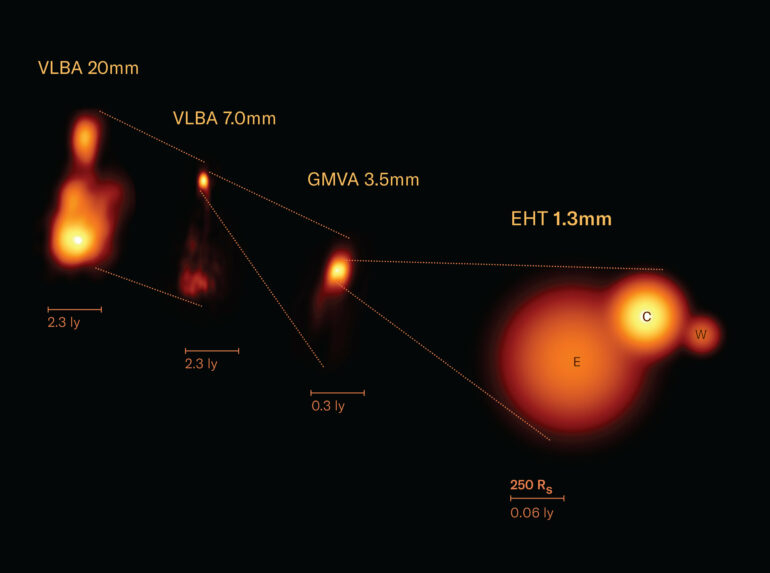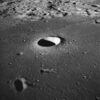The Event Horizon Telescope collaboration, including scientists from the Max Planck Institute for Radio Astronomy in Bonn, Germany, has recently resolved the jet base of an evolving jet of plasma at ultra-high angular resolution.
The international team of scientists used the Earth-size telescope to probe the magnetic structure in the nucleus of the radio galaxy 3C 84 (Perseus A), one of the closest active supermassive black holes in our cosmic neighborhood.
These novel results provide new insight into how jets are launched, revealing that in this cosmic tug of war, the magnetic fields overpower gravity. The study is published in the journal Astronomy & Astrophysics.
The strong radio source 3C 84 or Perseus A corresponds to NGC 1275, the central galaxy in the Perseus cluster at a distance of 230 million light years. It hosts a relatively nearby active galactic nucleus, allowing for a detailed investigation of the central source at high resolution with the Event Horizon Telescope (EHT).
“Besides providing first images of black holes, the EHT is supremely suitable to observe astrophysical jets of plasma and their interplay with strong magnetic fields,” says Georgios Filippos Paraschos, researcher at the Max Planck Institute for Radio Astronomy (MPIfR), who led the project. “Our new findings provide new evidence that an ordered magnetic field extends throughout the heated gas enveloping the black hole.”
The groundbreaking observations made by the EHT enable the scientists to address enduring questions regarding the process by which black holes accrete matter and eject powerful jets, reaching distances beyond their host galaxies.
In recent years, the Event horizon Telescope has unveiled images showing the direction of the light oscillation around the M 87* black hole. This property of the emitted light, called linear polarization, provides clues about the underlying magnetic field. In particular, strong linear polarization, as found in the present study, hints at a strong, well-ordered magnetic field in the 3C 84 black hole vicinity.
Notably, such powerful magnetic fields are thought to be the driving force behind the launching of such plasma jets, consisting of matter that was not consumed by the black hole.
“The radio galaxy 3C 84 is particularly interesting for the challenges it presents in detecting and accurately measuring the polarization of light near its black hole,” notes Jae-Young Kim, associate professor for astrophysics at Kyungpook National University (Daegu, South Korea), also affiliated with the MPIfR. “The Event Horizon Telescope’s exceptional capability to penetrate the dense, interstellar gas marks a groundbreaking advancement for precisely observing the vicinity of black holes.”
Such high-precision observations pave the way for discovering and studying other supermassive black holes that have remained hidden and elusive to previous observational technologies.
Their findings also shed light on the way mass is accreted onto the supermassive black hole, which is via advection. The infalling matter is thought to form a strongly magnetized, so-called magnetically arrested disk.
In this scenario, the magnetic field lines within the accretion disk become tightly wound and twisted, preventing the efficient release of magnetic energy. Furthermore, the study implies that the 3C 84 black hole is rapidly rotating, thus favoring an association between jet launching and large black hole spins.
“Why are black holes so good at producing powerful jets? This is one of the most fascinating questions in astrophysics,” says Maciek Wielgus, a researcher at the MPIfR. “We expect that general relativistic effects occurring just above the black hole’s event horizon may be the key to answer this question. Such high resolution observations are finally paving the way towards an observational verification.”
These exciting new results have been made possible by utilizing the technique of very-long-baseline interferometry or VLBI, in which a number of telescopes observe the same object in the sky and then combine the collected signals to produce an image. This way they act as a virtual telescope of the size as large as the diameter of the Earth.
“We are extremely excited because these results are a significant step towards understanding galaxies such as 3C 84. Together with our international partners, we are striving to improve the capabilities of the Event Horizon Telescope, to enable even more detailed insight on jet formation around black holes,” concludes Anton Zensus, Director at the MPIfR and head of it’s Radio Astronomy / VLBI research department.
More information:
G. F. Paraschos et al, Ordered magnetic fields around the 3C 84 central black hole, Astronomy & Astrophysics (2024). DOI: 10.1051/0004-6361/202348308
Provided by
Max Planck Society
Citation:
Magnetic launch of black hole jets in Perseus A (2024, February 1)



